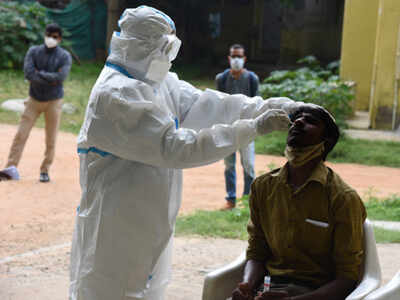
HYDERABAD: In a major cause for concern, city scientists have estimated the potential Covid-19 cases in Hyderabad at 6.6 lakh, seven times more than the total novel coronavirus cases detected so far in Telangana.
The number of officially declared Covid-19 positive cases in the state stands at 95,700, while the scientists have estimated that at least 6.6 lakh people in Hyderabad alone may have been infected by the pandemic virus. This in other words means that 6.6 per cent of the city’s population of one crore has been exposed to the Covid-19 with or without symptoms.
As several international studies have revealed that the novel coronavirus is shed through faeces, researchers from the city-based Centre for Cellular and Molecular Biology (CCMB) and the Indian Institute of Chemical Technology (IICT) scouted sewage water at the sewage treatment plants (STPs) of the Greater Hyderabad Municipal Corporation (GHMC) and found the pandemic virus. They estimated that 6.6 per cent of the population may have been infected.
Individuals infected by Covid-19 shed virus not only through nose and mouth but also through faeces. “This provides an opportunity to use ewage/wastewater samples to estimate the spread of the infection in a given locality or area. The novel coronavirus in sewage samples is non-infectious, thus making sewage samples suitable for epidemiological studies. Estimating the spread is very important in identifying the affected areas and controlling the pandemic,” the CCMB said in an official statement.
Since an infected person sheds viral material in faecal samples for up to 35 days, these studies will provide an overall estimate of the situation in a window of one month. Though about 1800 million litres water is used daily in Hyderabad, only 40% of it is processed at STPs.
The study covered about 80% of the STPs in Hyderabad. Analysis of the samples for viral load showed that there are about two lakh people are shedding the virus through faeces. Since only 40% of the city sewage reaches STPs, this data can be used to extrapolate the overall number of potentially infected people, which turned out to be about 6.6 lakh or about 6.6% of the city’s population, which includes symptomatic, asymptomatic, and individuals, who recovered in the past 35 days.
“A conservative estimate of the number of active cases, who are shedding the virus may be around 2.6 lakhs,” the study published on MedRxiv said.
“Our finding clearly indicates that a large proportion of the affected individuals are asymptomatic and did not need hospitalization. This is also in agreement with the observation that hospitalization rush or mortality is way lower than otherwise expected with such a large infection rate at a given time. It explains why our healthcare system has been able handle reasonably well the situation during the pandemic,” said CCMB director Dr Rakesh Kumar Mishra.
The number of officially declared Covid-19 positive cases in the state stands at 95,700, while the scientists have estimated that at least 6.6 lakh people in Hyderabad alone may have been infected by the pandemic virus. This in other words means that 6.6 per cent of the city’s population of one crore has been exposed to the Covid-19 with or without symptoms.
As several international studies have revealed that the novel coronavirus is shed through faeces, researchers from the city-based Centre for Cellular and Molecular Biology (CCMB) and the Indian Institute of Chemical Technology (IICT) scouted sewage water at the sewage treatment plants (STPs) of the Greater Hyderabad Municipal Corporation (GHMC) and found the pandemic virus. They estimated that 6.6 per cent of the population may have been infected.
Individuals infected by Covid-19 shed virus not only through nose and mouth but also through faeces. “This provides an opportunity to use ewage/wastewater samples to estimate the spread of the infection in a given locality or area. The novel coronavirus in sewage samples is non-infectious, thus making sewage samples suitable for epidemiological studies. Estimating the spread is very important in identifying the affected areas and controlling the pandemic,” the CCMB said in an official statement.
Since an infected person sheds viral material in faecal samples for up to 35 days, these studies will provide an overall estimate of the situation in a window of one month. Though about 1800 million litres water is used daily in Hyderabad, only 40% of it is processed at STPs.
The study covered about 80% of the STPs in Hyderabad. Analysis of the samples for viral load showed that there are about two lakh people are shedding the virus through faeces. Since only 40% of the city sewage reaches STPs, this data can be used to extrapolate the overall number of potentially infected people, which turned out to be about 6.6 lakh or about 6.6% of the city’s population, which includes symptomatic, asymptomatic, and individuals, who recovered in the past 35 days.
“A conservative estimate of the number of active cases, who are shedding the virus may be around 2.6 lakhs,” the study published on MedRxiv said.
“Our finding clearly indicates that a large proportion of the affected individuals are asymptomatic and did not need hospitalization. This is also in agreement with the observation that hospitalization rush or mortality is way lower than otherwise expected with such a large infection rate at a given time. It explains why our healthcare system has been able handle reasonably well the situation during the pandemic,” said CCMB director Dr Rakesh Kumar Mishra.

Coronavirus outbreak
Trending Topics
LATEST VIDEOS
City
 SC orders CBI probe into SSR death: Full faith that the family will get justice, says Bihar CM Nitish Kumar
SC orders CBI probe into SSR death: Full faith that the family will get justice, says Bihar CM Nitish Kumar  Sushant Singh Rajput death: Family welcomes Supreme Court's verdict, creates a new twitter account 'United For Justice'
Sushant Singh Rajput death: Family welcomes Supreme Court's verdict, creates a new twitter account 'United For Justice'  Former President Pranab Mukherjee's health declines, develops lung infection
Former President Pranab Mukherjee's health declines, develops lung infection  Sushant Singh Rajput death case: SC respected sentiments of crores of people, says Chirag Paswan
Sushant Singh Rajput death case: SC respected sentiments of crores of people, says Chirag Paswan
More from TOI
Navbharat Times
Featured Today in Travel
Get the app





